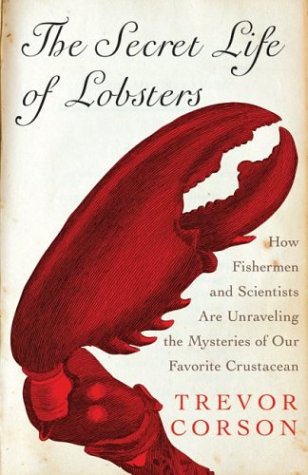The Secret Life of Lobsters – Trevor Corson

Journalist Trevor Corson spent two years lobstering off the coast of Maine in the United States, giving him an excellent understanding of the rigours of that (or any) fishery, and its seasonal dynamics. (It also invested him, perhaps too deeply to allow him sufficient objectivity to tell this story, in relationships with the fishermen working there.)
He centres his book on the community of Little Cranberry island off Maine, a ridiculously beautiful island with a small permanent population, sustained by fishing for American lobster. These crustaceans can weigh up to 20 kilograms and are the heaviest in the world. He interweaves stories of the lobstermen at work with stories of the scientists who study the animals, and with details of the life of lobsters. (The title of the book is apt.) His characterisations of all of the individuals who appear in the book are fully formed, and by the end one feels a warm familiarity for many of them.
At the heart of the book is a conflict between scientists employed by the United States government to make recommendations regarding the management of its fisheries, who insisted for years that the lobsters of Maine are overfished, and the lobster fishing community, which has seen catches rising, has implemented their own measures to protect very small and very large lobsters and females (one of which is notching the tails of actively breeding females to indicate that they shouldn’t be kept), and is convinced that the stock is healthy.
Corson makes no secret of his antipathy for the “government scientists” who predicted the fishery’s disappearance and his disdain for their fears, but fails to explain why they are so convinced the stock is in danger of collapse. New England, the primary range of the American lobster, is the site of the devastating failure of a massive and lucrative cod fishery (in short, they were all eaten), and perhaps this failure informs the scientists concerned with excessive caution.
The Maine lobster fishery has, since 1995, evolved a system of co-management between regulations set by the government to manage the fishery, and management systems imposed and maintained by the fishermen themselves. This is an innovative and effective way of avoiding a “tragedy of the commons” (here’s Garrett Hardin’s original paper) that can arise when a common resource is free to be exploited by everyone. The Maine lobster fishery is presented at the end of Elinor Ostrom’s 1998 paper on coping with tragedies of the commons, as an example of how decentralised (or polycentric) management systems can work for common resources such as fisheries, clean water, or clean air. With very few government patrols, the fishery is kept regulated largely by its participants – the fishermen themselves. This is a fascinating success story. James Acheson, an economic anthropologist, has studied this fishery extensively. Some of his papers can be found here and here. Attempts to manage marine resources in a centralised, top down manner don’t work (c.f. abalone in South Africa – or all our fisheries, for that matter), and co-management solutions in which industry participates with government seem to be a very viable and effective solution.
The scientists Corson profiles are renegades (at least in comparison to the government’s people), who favour experiments and field work (involving scuba dives, ROVs and many laboratory tanks of lobster) over calculations and theory, and who back up the claims of the fishermen that the lobster population is healthy. I’m afraid the demonising of the government scientists didn’t sit well with me, and perhaps with a little more explanation or attempt to understand their perspective, Corson could have presented a more nuanced take on the matter. Lobster catches continue to boom in Maine, but because of larval lobsters’ dependence on ocean currents and water temperatures to usher in each phase of their development, global warming and the resulting changes in ocean currents and ocean temperatures could impact this fishery adversely in the future.
The details about lobster biology and behaviour that Corson presents are fascinating, and, I suspect, an excellent layperson’s substitute for wading through all the scientific literature on the life and times of the American lobster. He explains how the scientists reached their conclusions, too, giving detailed descriptions of experiments involving superglue, plastic tube, and long term observation of both wild and captive lobsters. I think (hope) a lot of what I learned here is generalisable to our own West coast rock lobsters: as I pointed out to Tony while I was explaining to him how male American lobsters urinate on one another from their heads while they fight vigorously over territory and mates, we don’t often observe lobsters behaving when we encounter them on dives. We sometimes see them eating, but most often they scoot backwards into a hiding place, or just gently wave their antennae at us. They have intricate social and reproductive lives, not to mention a dizzyingly complex life cycle (the difficulty of artificially replicating the conditions required for multiple larval transformations are part of the reason why they aren’t farmed like abalone). I will certainly be watching more closely next time I bump into one of these remarkable crustaceans.
This book has its origins in an article Corson wrote for the Atlantic, which features many of the characters who appear in The Secret Life of Lobsters – you can check it out to see if it catches your interest. Also, a second viewing of Deadliest Catch – Lobster Wars might be in order, after everything I’ve learned from this book.
You can get a copy of the book here if you’re in South Africa, otherwise here or here.







